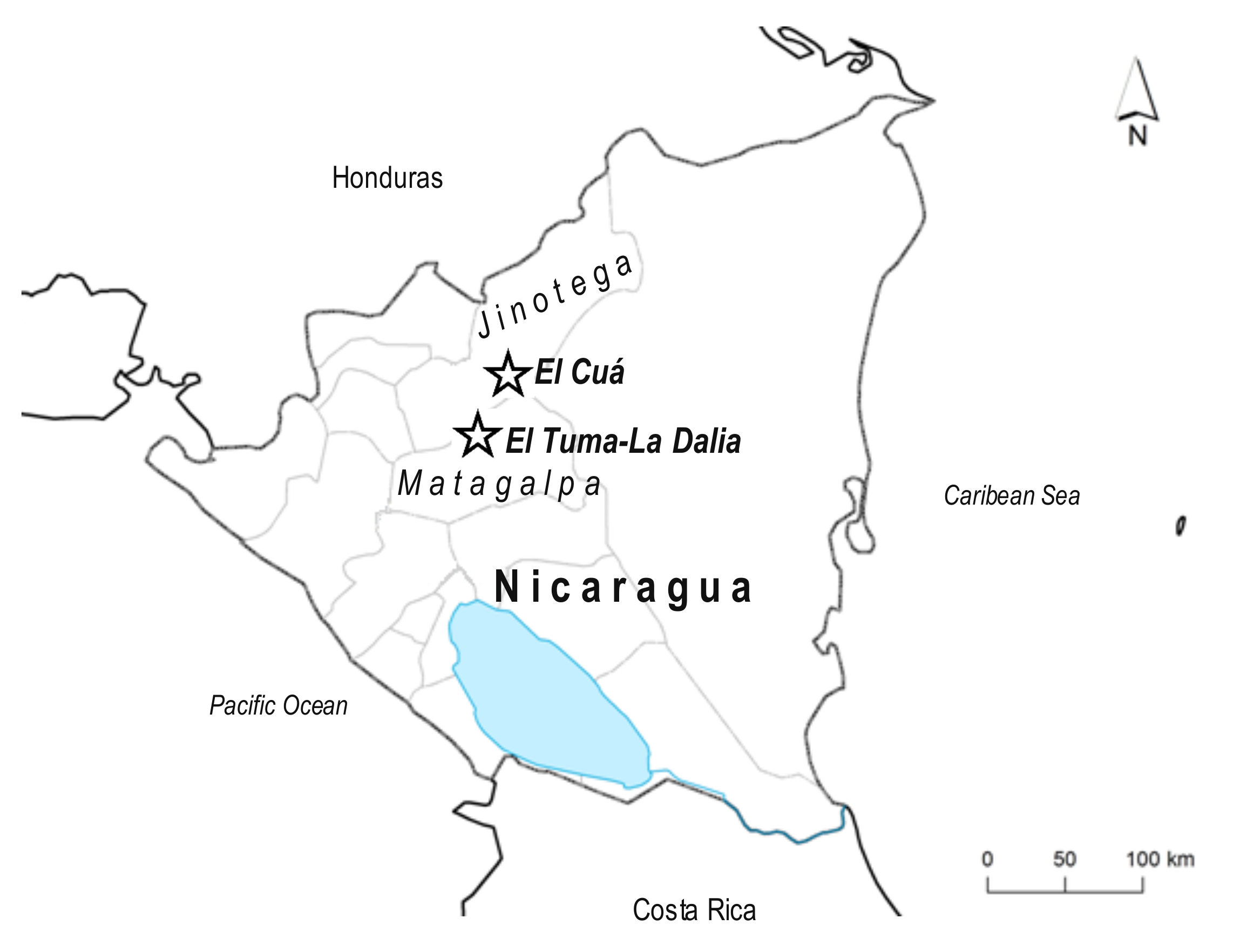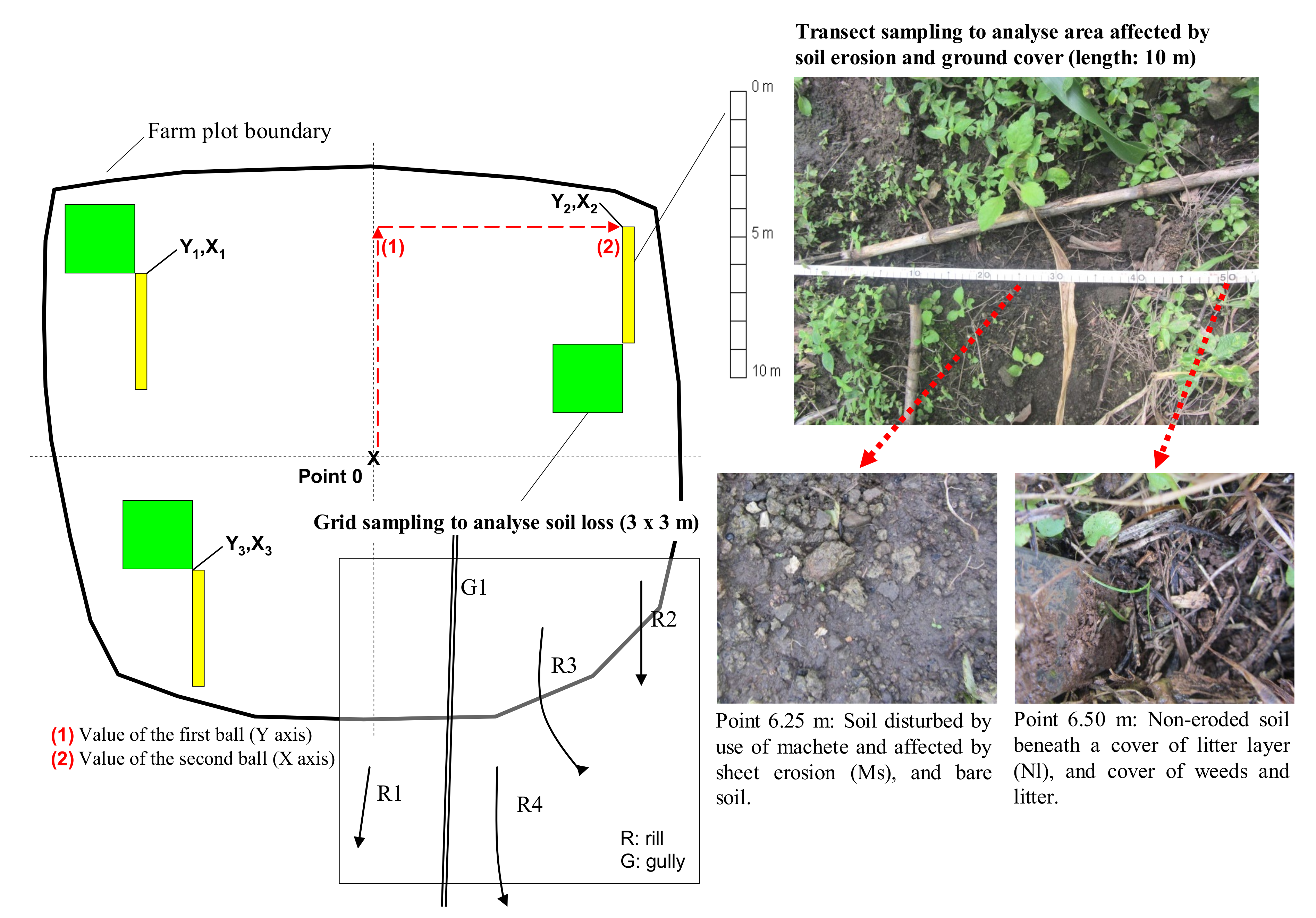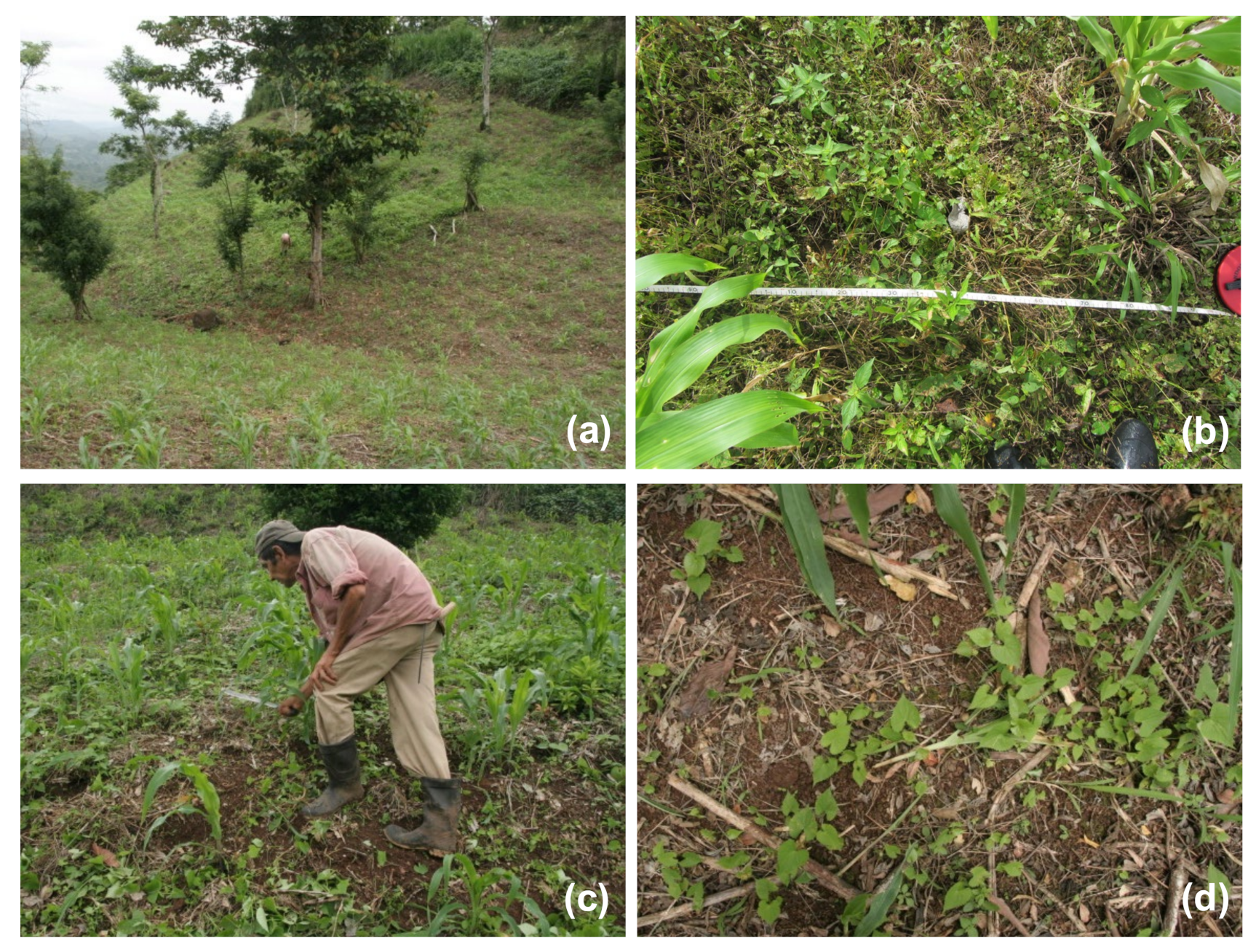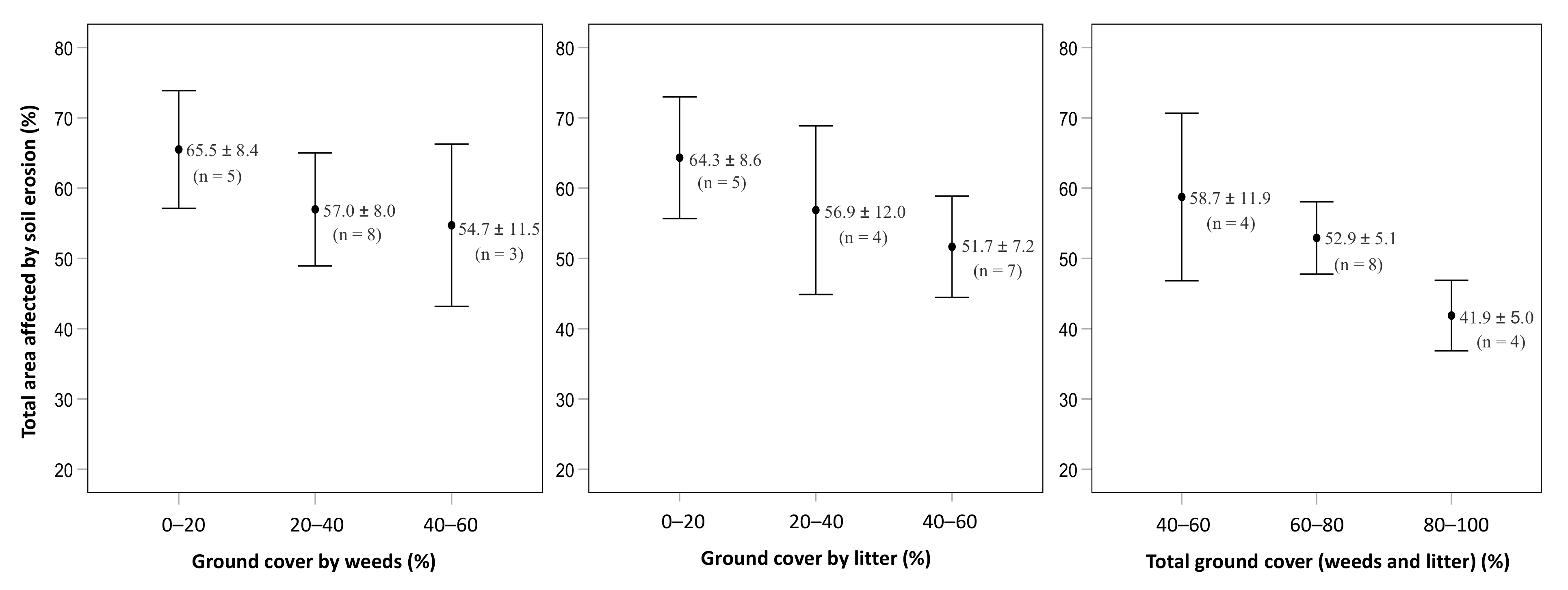Impact of Weed Control by Hand Tools on Soil Erosion under a No-Tillage System Cultivation
Abstract
1. Introduction
2. Materials and Methods
2.1. Site Characteristics
2.2. Crop Management
2.3. Soil Erosion Analysis and Calculation of Ground Vegetal Cover
2.4. Research Design and Statistical Analysis
3. Results
3.1. The State of Soil Erosion and the Ground Cover
3.2. Influence of Ground Cover on Soil Erosion
4. Discussion
5. Conclusions
Author Contributions
Funding
Institutional Review Board Statement
Informed Consent Statement
Data Availability Statement
Conflicts of Interest
References
- Development Initiatives. Global Nutrition Report: Shining a Light to Spur Action on Nutrition; Development Initiatives Poverty Research Ltd.: Bristol, UK, 2018; Available online: https://www.who.int/nutrition/globalnutritionreport/2018_Global_Nutrition_Report.pdf (accessed on 17 September 2020).
- FAO. The State of Food-Based Dietary Guidelines in Latin America and the Caribbean; FAO: Rome, Italy, 2014; Available online: http://www.fao.org/3/a-i3677s.pdf (accessed on 5 July 2020). (In Spanish)
- FAO. Food and Agriculture Organization of the United Nations, FAOSTAT. 2020. Available online: http://www.fao.org/faostat/en/#data/QC (accessed on 14 September 2020).
- Piñeiro, M.; Trigo, E.; Fiorentino, R. Technical change in Latin American agriculture. Food Policy 1979, 4, 169–177. [Google Scholar] [CrossRef]
- Zeledon, E.B.; Kelly, N.M. Understanding large-scale deforestation in southern Jinotega, Nicaragua from 1978 to 1999 through the examination of changes in land use and land cover. J. Environ. Manag. 2009, 90, 2866–2872. [Google Scholar] [CrossRef]
- Wantzen, K.M.; Mol, J.H. Soil Erosion from Agriculture and Mining: A Threat to Tropical Stream Ecosystems. Agriculture 2013, 3, 660–683. [Google Scholar] [CrossRef]
- Lal, R. Soil erosion impact on agronomic productivity and environment quality. Crit. Rev. Plant Sci. 1988, 17, 319–464. [Google Scholar] [CrossRef]
- Öborn, I.; Vanlauwe, B.; Atta-Krah, K.; Thomas, T.; Phillips, M.; Schut, M. Integrated systems research for sustainable intensification of smallholder agriculture. In Sustainable Intensification in Smallholder Agriculture: An Integrated Systems Research Approach; Öborn, I., Atta-Krah, K., Phillips, M., Thomas, R., Vanlauwe, B., Brooijmans, W., Eds.; Routledge: London, UK; New York, NY, USA, 2017; pp. 32–46. [Google Scholar]
- Kang, M.S.; Banga, S.S. Global agriculture and climate change. J. Crop Improv. 2013, 27, 667–692. [Google Scholar] [CrossRef]
- Lal, R. Tillage systems in the tropics. In Management Options and Sustainability Implications; FAO Soils Bulletin No. 71; FAO: Roma, Italy, 1995. [Google Scholar]
- Evans, R. Sustainable practices to limit soil erosion: A review and discussion. Cab Rev. 2006, 1, 1–12. [Google Scholar] [CrossRef]
- Reicosky, D.C.; Saxton, K.E. The benefits of no-tillage. In No-Tillage Seeding in Conservation Agriculture; Baker, C.J., Saxton, K.E., Eds.; FAO and CAB International: Roma, Italy, 2007; pp. 11–20. [Google Scholar]
- Bradford, J.M.; Huang, C. Interrill soil erosion as affected by tillage and residue cover. Soil Tillage Res. 1994, 31, 353–361. [Google Scholar] [CrossRef]
- Mondal, S.; Chakraborty, D.; Bandyopadhyay, K.; Aggarwal, P.; Rana, D.S. A global analysis of the impact of zero-tillage on soil physical condition, organic carbon content, and plant root response. Land Degrad. Dev. 2020, 31, 557–567. [Google Scholar] [CrossRef]
- Carr, P.M.; Gramig, G.G.; Liebig, M.A. Impacts of organic zero tillage systems on crops, weeds, and soil quality. Sustainability 2013, 5, 3172–3201. [Google Scholar] [CrossRef]
- Chowdhury, S.; Farrell, M.; Butler, G.; Bolan, N. Assessing the effect of crop residue removal on soil organic carbon storage and microbial activity in a no-till cropping system. Soil Use Manag. 2015, 31, 384–396. [Google Scholar] [CrossRef]
- FAO. Soil Erosion: The Greatest Challenge to Sustainable Soil Management; FAO: Rome, Italy, 2019; Available online: http://www.fao.org/3/ca4395en/ca4395en.pdf (accessed on 10 March 2020).
- Sims, B.; Corsi, S.; Gbehounou, G.; Kienzle, J.; Taguchi, M.; Friedrich, T. Sustainable weed management for conservation agriculture: Options for smallholder farmers. Agriculture 2018, 8, 118. [Google Scholar] [CrossRef]
- Blanco, R.; Enríquez, F. Erosion control in the sustainable cultivation of maize (Zea mays L.) and beans (Phaseolus vulgaris L.) at two stages of the agricultural cycle in Southern Guatemala. Sustainability 2018, 10, 4654. [Google Scholar]
- Pittelkow, C.M.; Linquist, B.A.; Lundy, M.E.; Liang, X.; Van Groenigen, K.J.; Lee, J.; Van Gestel, N.; Six, J.; Venterea, R.T.; Van Kessel, C. When does no-till yield more? A global meta-analysis. Field Crop. Res. 2015, 183, 156–168. [Google Scholar] [CrossRef]
- Kornecki, T.S.; Price, A.J. Management of High-Residue Cover Crops in a Conservation Tillage Organic Vegetable On-Farm Setting. Agronomy 2019, 9, 640. [Google Scholar] [CrossRef]
- Magrin, G.O.; Marengo, J.A.; Boulanger, J.P.; Buckeridge, M.S.; Castellanos, E.; Poveda, G.; Scarano, F.R.; Vicuña, S. Central and South America. In Climate Change 2014: Impacts, Adaptation, and Vulnerability. Part B: Regional Aspects; Contribution of Working Group II to the Fifth Assessment Report of the Intergovernmental Panel on Climate Change; Barros, V.R., Field, C.B., Dokken, D.J., Mastrandrea, M.D., Mach, K.J., Bilir, T.E., Chatterjee, M., Ebi, K.L., Estrada, Y.O., Genova, R.C., Eds.; Cambridge University Press: Cambridge, UK; New York, NY, USA, 2014; pp. 1499–1566. [Google Scholar]
- FAO-ISRIC-ISSS. World Reference Base for Soil Resources; World Soil Resources Reports No. 84; FAO: Rome, Italy, 1998; Available online: http://www.fao.org/3/W8594E/w8594e00.htm (accessed on 17 September 2015).
- FAO. Manual on Integrated Soil Management and Conservation Practices; Land and Water Bulletin No. 8; FAO: Rome, Italy, 2000; Available online: http://www.fao.org/3/x4799e/x4799e.pdf (accessed on 21 January 2019).
- Blanco, R. An erosion control and soil conservation method for agrarian uses based on determining the erosion threshold. MethodsX 2018, 5, 761–772. [Google Scholar] [CrossRef]
- Stocking, M.; Murnaghan, N. Handbook for the Field Assessment of Land Degradation; Earthscan Pub. Ltd.: London-Sterling, UK, 2001. [Google Scholar]
- Hudson, N.W. Field Measurement of Soil Erosion and Runoff; FAO Soils Bulletin: Rome, Italy, 1993. [Google Scholar]
- Creswell, J.W. Research Design. Qualitative, Quantitative, and Mixed Methods Approaches, 4th ed.; SAGE Publications, Inc.: Thousand Oaks, CA, USA, 2014. [Google Scholar]
- Poesen, J.; Nachtergaele, J.; Verstraeten, G.; Valentin, C. Gully erosion and environmental change: Importance and research needs. Catena 2003, 50, 91–133. [Google Scholar] [CrossRef]
- Prosdocimi, M.; Tarolli, P.; Cerdà, A. Mulching practices for reducing soil water erosion: A review. Earth-Sci. Rev. 2016, 161, 191–203. [Google Scholar] [CrossRef]
- Farres, P.J. The dynamics of rainsplash erosion and the role of soil aggregate stability. Catena 1987, 14, 119–130. [Google Scholar] [CrossRef]
- Van Dijk, P.M.; Van der Zijp, M.; Kwaad, F.J.P.M. Soil erodibility parameters under various cropping systems of maize. Hydrol. Process. 1996, 10, 1061–1067. [Google Scholar] [CrossRef]
- Blanco, R.; Aguilar, A. The erosion threshold for a sustainable agriculture in cultures of bean (Phaseolus vulgaris L.) under conventional tillage and no-tillage in Northern Nicaragua. Soil Use Manag. 2016, 32, 368–380. [Google Scholar] [CrossRef]
- García-Ruiz, J.M.; Beguería, S.; Nadal-Romero, E.; Gonzalez-Hidalgo, J.C.; Lana-Renault, N.; Sansjuan, Y. A meta-analysis of soil erosion rates across the world. Geomorphology 2015, 239, 160–173. [Google Scholar] [CrossRef]
- Derpsch, R.; Sidiras, N.; Roth, C.H. Results of studies made from 1977 to 1984 to control erosion by cover crops and no-tillage techniques in Parana, Brazil. Soil Tillage Res. 1986, 8, 253–263. [Google Scholar] [CrossRef]
- Smith, G.D.; Coughlan, K.J.; Yule, D.F.; Laryea, K.B.; Srivastava, K.L.; Thomas, N.P.; Cogle, A.L. Soil management options to reduce runoff and erosion on a hardsetting Alfisol in the semi-arid tropics. Soil Tillage Res. 1992, 25, 195–215. [Google Scholar] [CrossRef][Green Version]
- Leys, A.; Govers, G.; Gillijns, K.; Berckmoes, E.; Takken, I. Scale effects on runoff and erosion losses from arable land under conservation and conventional tillage: The role of residue cover. J. Hydrol. 2010, 390, 143–154. [Google Scholar] [CrossRef]
- Prosdocimi, M.; Jordán, A.; Tarolli, P.; Keesstra, S.; Novara, A.; Cerdà, A. The immediate effectiveness of barley straw mulch in reducing soil erodibility and surface runoff generation in Mediterranean vineyards. Sci. Total Environ. 2016, 547, 323–330. [Google Scholar] [CrossRef]
- Arshad, M.A.; Franzluebbers, A.J.; Azooz, R.H. Components of surface soil structure under conventional and no-tillage in northwestern Canada. Soil Tillage Res. 1999, 53, 41–47. [Google Scholar] [CrossRef]
- Zhang, G.S.; Chan, K.Y.; Oates, A.; Heenan, D.P.; Huang, G.B. Relationship between soil structure and runoff/soil loss after 24 years of conservation tillage. Soil Tillage Res. 2007, 92, 122–128. [Google Scholar] [CrossRef]
- Lal, R. Soils and sustainable agriculture. A review. Agron. Sustain. Dev. 2008, 28, 57–64. [Google Scholar] [CrossRef]
- Blanco, R. Video Weed-Control Coffee. Available online: https://youtu.be/vogi8aktZs6o (accessed on 5 May 2021).





| M. Mechanical Soil Disturbance By Tool (Machete), Affected By Erosion, or Erosion-Susceptible |
| 1. (Mes) Soil disturbed by tool use and susceptible to erosion (but not visible at present) |
| 2. (Mi/Ms/Mr/Mg) Soil disturbed by tool use and affected by splash erosion (raindrop impact)/by sheet erosion (removal of a soil layer less than 3 cm deep by surface water flow)/by erosion in rills/by erosion in gullies (linear soil erosion channel less than 30 cm deep in the case of rills and more in gullies) |
| T. Mechanical soil disturbance by trampling, affected by erosion, or erosion-susceptible |
| 1. (Tes) Soil disturbed by trampling and susceptible to erosion (but not visible at present) |
| 2. (Ti/Ts/Tr/Tg) Soil disturbed by trampling and affected by splash erosion/by sheet erosion/by erosion in rills/by erosion in gullies |
| D. Soil deposition affected by erosion or erosion-susceptible |
| 1. (Des) Soil deposition susceptible to erosion (but not visible at present) |
| 2. (Di/Ds/Dr/Dg) Soil deposition affected by splash erosion/by sheet erosion/by erosion in rills/by erosion in gullies |
| N. No erosion |
| 1. (Nw) No evidence of erosion beneath cover of weeds |
| 2. (Nl) No evidence of erosion beneath litter layer |
| O. Others |
| 1. (Or) Stones |
| 2. (Oa) Animals: tracks, feces, carcasses, others. |
| Processes and Water Erosion Types | Abbreviation | Mean ± Standard Error |
|---|---|---|
| Soil disturbed by machete and susceptible to erosion (but no erosion currently visible) (%) | Mes | 9.6 ± 2.4 |
| Soil disturbed by tool use and affected by splash erosion (%) | Mi | 24.6 ± 5.9 |
| Soil disturbed by tool use and affected by sheet erosion (%) | Ms | 33.3 ± 4.4 |
| Soil disturbed by trampling and susceptible to erosion (but no erosion currently visible) (%) | Tes | 0.3 ± 0.2 |
| Soil disturbed by trampling and affected by splash erosion (%) | Ti | 0.2 ± 0.1 |
| Soil disturbed by trampling and affected by sheet erosion (%) | Ts | 1.0 ± 0.4 |
| Soil deposition affected by splash erosion (%) | Di | 0.1 ± 0.1 |
| No evidence of erosion beneath cover of weeds (%) | Nw | 13.5 ± 2.5 |
| No evidence of erosion beneath litter layer (%) | Nl | 13.7 ± 2.7 |
| Other topsoil characteristics (stones) (%) | Or | 3.6 ± 1.3 |
| Total area affected by soil erosion (%) | Et | 59.2 ± 5.0 |
| Total area not affected by soil erosion (%) | Ene | 37.2 ± 5.3 |
| Soil loss (m3 ha−1) | Esl | 0 |
| Characteristics | Abbreviation | Mean ± Standard Error |
|---|---|---|
| Ground cover by weeds (%) | GCW | 33.9 ± 5.7 |
| Ground cover by litter (%) | GCL | 33.8 ± 4.7 |
| Total ground cover (weeds and litter) (%) | GCW-L | 67.7 ± 4.2 |
| Et | GCW | GCL | GCW-L | |
|---|---|---|---|---|
| Et | 1 | −0.20 (p = 0.457) | −0.20 (p = 0.460) | −0.27 (p = 0.304) |
| GCW | 1 | −0.67 (p = 0.004) | 0.54 (p = 0.003) | |
| GCL | 1 | 0.07 (p = 0.795) | ||
| GCW-L | 1 |
| Ground Cover Types | Cover Intervals (%) (n for Each Interval) | Results |
|---|---|---|
| Ground cover by weeds | 0–20, 20–40, 40–60 (n = 5, 8, 3) | Chi-square = 1.35, p = 0.509 |
| Ground cover by litter | 0–20, 20–40, 40–60 (n = 5, 4, 7) | Chi-square = 0.62, p = 0.735 |
| Total ground cover (weeds and litter) | 40–60, 60–80, 80–100 (n = 4, 8, 4) | Chi-square = 2.11, p = 0.348 |
Publisher’s Note: MDPI stays neutral with regard to jurisdictional claims in published maps and institutional affiliations. |
© 2021 by the authors. Licensee MDPI, Basel, Switzerland. This article is an open access article distributed under the terms and conditions of the Creative Commons Attribution (CC BY) license (https://creativecommons.org/licenses/by/4.0/).
Share and Cite
Blanco-Sepúlveda, R.; Aguilar-Carrillo, A.; Lima, F. Impact of Weed Control by Hand Tools on Soil Erosion under a No-Tillage System Cultivation. Agronomy 2021, 11, 974. https://doi.org/10.3390/agronomy11050974
Blanco-Sepúlveda R, Aguilar-Carrillo A, Lima F. Impact of Weed Control by Hand Tools on Soil Erosion under a No-Tillage System Cultivation. Agronomy. 2021; 11(5):974. https://doi.org/10.3390/agronomy11050974
Chicago/Turabian StyleBlanco-Sepúlveda, Rafael, Amilcar Aguilar-Carrillo, and Francisco Lima. 2021. "Impact of Weed Control by Hand Tools on Soil Erosion under a No-Tillage System Cultivation" Agronomy 11, no. 5: 974. https://doi.org/10.3390/agronomy11050974
APA StyleBlanco-Sepúlveda, R., Aguilar-Carrillo, A., & Lima, F. (2021). Impact of Weed Control by Hand Tools on Soil Erosion under a No-Tillage System Cultivation. Agronomy, 11(5), 974. https://doi.org/10.3390/agronomy11050974






